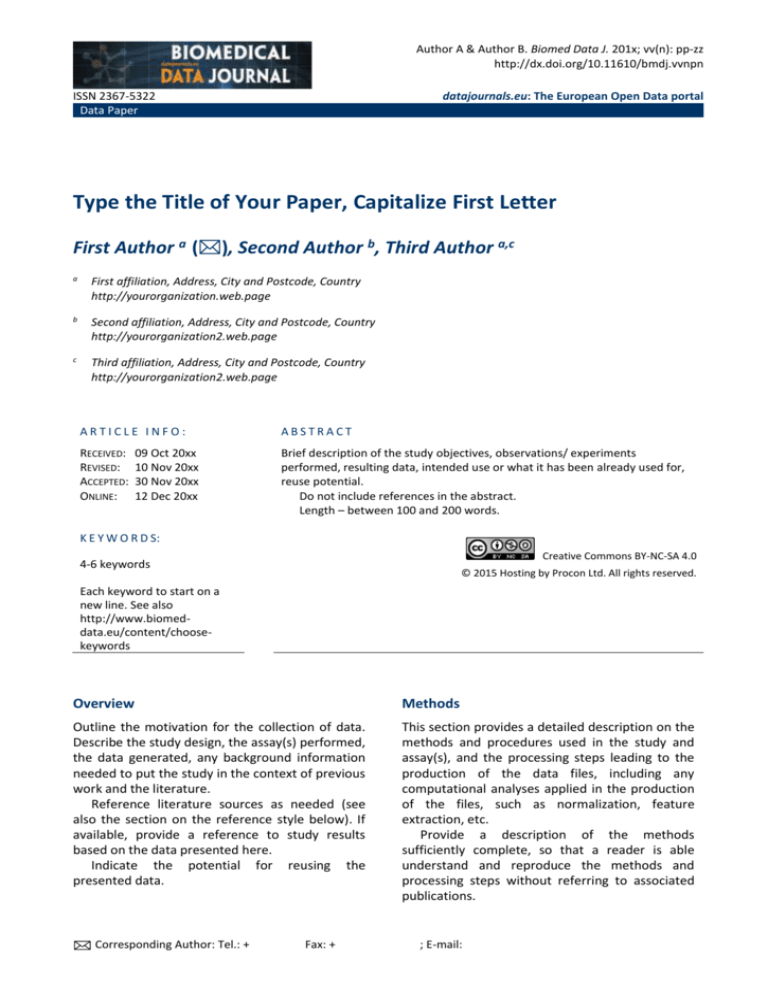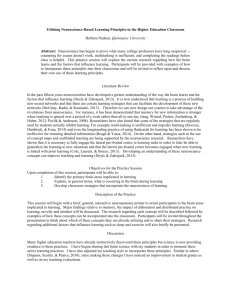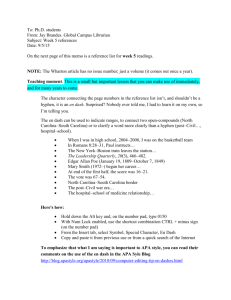
Author A & Author B. Biomed Data J. 201x; vv(n): pp-zz
http://dx.doi.org/10.11610/bmdj.vvnpn
ISSN 2367-5322
Data Paper
datajournals.eu: The European Open Data portal
Type the Title of Your Paper, Capitalize First Letter
First Author a (), Second Author b, Third Author a,c
a
First affiliation, Address, City and Postcode, Country
http://yourorganization.web.page
b
Second affiliation, Address, City and Postcode, Country
http://yourorganization2.web.page
c
Third affiliation, Address, City and Postcode, Country
http://yourorganization2.web.page
ARTICLE INFO:
ABSTRACT
RECEIVED:
REVISED:
ACCEPTED:
ONLINE:
Brief description of the study objectives, observations/ experiments
performed, resulting data, intended use or what it has been already used for,
reuse potential.
Do not include references in the abstract.
Length – between 100 and 200 words.
09 Oct 20xx
10 Nov 20xx
30 Nov 20xx
12 Dec 20xx
K E Y W O R D S:
Creative Commons BY-NC-SA 4.0
4-6 keywords
© 2015 Hosting by Procon Ltd. All rights reserved.
Each keyword to start on a
new line. See also
http://www.biomeddata.eu/content/choosekeywords
Overview
Methods
Outline the motivation for the collection of data.
Describe the study design, the assay(s) performed,
the data generated, any background information
needed to put the study in the context of previous
work and the literature.
Reference literature sources as needed (see
also the section on the reference style below). If
available, provide a reference to study results
based on the data presented here.
Indicate the potential for reusing the
presented data.
This section provides a detailed description on the
methods and procedures used in the study and
assay(s), and the processing steps leading to the
production of the data files, including any
computational analyses applied in the production
of the files, such as normalization, feature
extraction, etc.
Provide a description of the methods
sufficiently complete, so that a reader is able
understand and reproduce the methods and
processing steps without referring to associated
publications.
Corresponding Author: Tel.: +
Fax: +
; E-mail:
Author A & Author B. Biomed Data J. 201x; vv(n): ??-??
Table 1. An example of a table.
Data Records
Explain each data record associated with this work
(a specific repository other than the OSL platform,
overview of the data files and file formats).
External data records should be cited using the
data citation format (see below).
An example of a column heading
Column A (t)
Column B (t)
And an entry
1
2
And another entry
3
4
And another entry
5
6
Validation
This section presents experiments or analyses
applied to support the technical quality of the
dataset(s).
1.3. Charts, figures, photos
All figures should be numbered with Arabic numerals (1,2,3,….). Every figure should have a caption. All photographs, schemas, graphs and diagrams are to be referred to as figures. Line drawings should be good quality scans or true electronic output. Low-quality scans are not acceptable. Figures must be embedded into the text and
not supplied separately. In MS word input the figures must be properly coded. Lettering and symbols should be clearly defined either in the caption
or in a legend provided as part of the figure. Figures should be placed at the top or bottom of a
page wherever possible, as close as possible to the
first reference to them in the paper.1
The figure number and caption should be
typed below the illustration in 10 pts and left justified.
Use and potential reuse
Briefly present the purposes for which the data
has already been used and provide a reference to
relevant publications (if any).
Provide brief instructions to facilitate data
reuse by other researchers.
Guidance on language, formatting and style
1.1. Spelling and format
Authors from the United States are welcome to
use U.S. spelling. All other authors, please use
consistently U.K. spelling. For referenced sources,
use the title as given in the original publication.
Bulleted lists may be included and should look
like this:
First point
Second point
And so on
Last bullet point.
Figure 1: Sample illustration.
Please do not alter the formatting and style
layouts which have been set up in this template
document. As indicated in the template, papers
should be prepared in double column format suitable for direct printing.
Page numbers will be added by the publisher.
If a chart or an image is too large to fit within
the column, create a new section by inserting two
continuous section breaks and select one-column
layout for this new section. See the example
below.
1.2. Tables
1.4. Construction of references
Use endnotes to cite a source in the text.2 Thus,
references are numbered consecutively in the list
at the end of the article in the order they are cited
in the text. Use font size 10 pts and single-spaced
paragraphs.
Use one endnote for each referenced source. If
you want to cite more than one source in support
of your point, separate endnote marks by a
coma.3,4
If you need to refer to a source more than
once, do not insert it again as an endnote, but use
instead Insert > Cross-reference and select Reference type “Endnote” and then the respective
endnote.
All tables should be numbered with Arabic numerals. Every table should have a caption. Headings should be placed above tables, left justified.
Only horizontal lines should be used within a table, to distinguish the column headings from the
body of the table, and immediately above and
below the table. Tables must be embedded into
the text and not supplied separately. Below is an
example which the authors may find useful.
If the table is too large to fit within the column,
create a new section by inserting two continuous
section breaks and select one-column layout for
this section.
18
The Title of Your Paper, Capitalize First Letter, Shorten if Necessary
Figure 2: Illustration of the biological scales for computational cancer models including atomic, molecular, microscopic and macroscopic.2
1.6. Footnotes
For the referenced sources BMDJ applies the
Style Guide of the US National Library of Medicine
(NLM). Please consult the NLM Style Guide,
http://www.nlm.nih.gov/citingmedicine. A short
guide on the main types of references is available
at http://www.biomed-data.eu/content/style.
At the end include the DOI number of the cited
source, include its DOI number.5 If a DOI is not
available, include its PubMed Identifier (PMID).
Most papers in the biomedical field will have at
least one of these identifiers assigned. If you wish
to cite a paper, a book, a report or an official document that does not have a DOI or PMID assigned,
please include the most recent working URL to the
source.
Footnotes should be avoided if possible. Necessary footnotes should be denoted in the text by
consecutive superscript roman numbers.ii The
footnotes should be typed single spaced, and in
smaller type size (10 pt), at the foot of the page in
which they are mentioned, and separated from
the main text by a one line space extending at the
foot of the column.6
Licenses
Authors who publish with BMDJ will retain all intellectual property rights, including moral rights in
their work. Data papers/metadata accompanying
the research data, including the abstract describing the research data, will be licensed to the public under “Creative Commons 4.0 AttributionNonCommercial-ShareAlike” International license
(CC BY-NC-SA 4.0).7
The datasets will be made available on the
OpenScienceLink platform or, in specific cases,
another agreed repository. BMDJ uses a variety of
licenses designed for and appropriate for the
treatment of data. The default license in
publishing data is the Open Data Commons
Attribution License (ODC-By), which is a license
1.5. References to datasets
Data citations provide bibliographic information
for the data records described in the manuscript.
These should be in the format “Lastname1
Initial(s)1, Lastname2 Initial(s)2, Lastname3
Initial(s)3.
Repository_name
Dataset_accession_number or DOI (Year).”
In the text of the paper refer to a dataset
placing its number in parentheses (Data Citation
1). You can use either the dataset accession
number or its DOI (Data Citation 2).
19
Author A & Author B. Biomed Data J. 201x; vv(n): ??-??
agreement intended to allow users to freely share,
modify, and use the published data(base),
provided that the data creators are attributed
(cited or acknowledged). Thus authors who
publish their data receive academic credit.
Licensing alternatives include Creative
Commons 1.0 (CC0, cited also as “CC-Zero” or “CCzero”),
https://creativecommons.org/choose/
zero/waiver and the Open Data Commons Public
Domain Dedication and Licence (PDDL),
www.opendatacommons.org/licenses/pddl/1-0/.
Data Citations
1
Finlayson SG, LePendu P, Shah NH. Dryad
http://dx.doi.org/10.5061/dryad.jp917 (2014).
2
Baric R, Katze M, Chang J, Gralinski L, Law L. Gene
Expression Omnibus GSE37569 (2012).
References
1
Zhang P, Brusic V. Mathematical modeling for novel
cancer drug discovery and development. Expert Opin
Drug Discov. 2014 Jul 25: 1-18. DOI: 10.1517/174604
41.2014.941351.
Conclusions
2
Once ready with the text, please hyphenate it using the feature incorporated in Word for Windows. Select ‘Manual’ hyphenation and do not
hyphenate titles, URL addresses and the like.
Avoid also hyphenation at the end of a line.
Once accepted and ready for online publication, the publisher will insert page numbers and
assign a DOI to your paper.
Kourou K, Fotiadis DI. Computational Modelling in
Cancer: Methods and Applications. Biomed Data J.
2015;1(1):15-25. DOI: 10.11610/bmdj.01103.
3
Pantos C, Schroeder M, Ivanova P. Open Access to
Quality Biomedical Experimental and Clinical Data and
Data-based Models. Biomed Data J. 2015;1(1):01-02.
DOI: 10.11610/bmdj.01101.
4
Guedj D, Ramjoué C. European Commission Policy
on Open-Access to Scientific Publications and Research
Data in Horizon 2020. Biomed Data J. 2015;1(1):11-14.
DOI: 10.11610/bmdj.01102.
Acknowledgements
Acknowledgements and Reference heading should
be left justified, bold, with the first letter capitalized but have no numbers. Text below continues
as normal.
5
Bunevicius A. The Need for Open-access, Structured
Data in Clinical Brain Research. Biomed Data J.
2015;1(1):27-32. DOI: 10.11610/bmdj.01104.
6
HORIZON 2020 Work programme 2014-2015,
Health, demographic change and wellbeing. PHC2Understanding diseases: systems medicine. Available
from: http://ec.europa.eu/research/participants/data/
ref/h2020/wp/2014_2015/main/h2020-wp1415health_en.pdf.
Appendix A. An example appendix
Authors including an appendix section should do
so before References section. Order multiple
appendices as Appendix A, B, C etc.
A.1. Example of a sub-heading within an
appendix
There is also the option to include a subheading
within the Appendix if necessary.
7
Hugelier S. Publishing Open-Access Biomedical
Data: Legal Challenges. Biomed Data J. 2015;1(1):43-51.
DOI: 10.11610/bmdj.01108.
20






